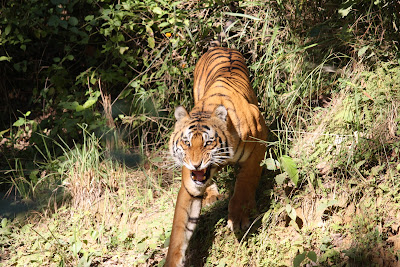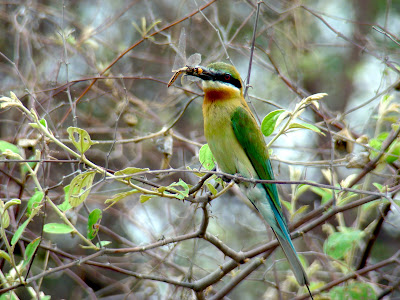On Monday, Jim’s Jungle Retreat was humbled, honored and extremely excited to host a discovery excursion for international donors looking to aid tiger conservation at Corbett Tiger Reserve under the guidance of WildAid, an international wildlife conservation organization, and the Virgin Group’s non-profit foundation Virgin Unite.
Sir Richard Branson and his son Sam Branson were here to encourage donors to give to this urgent and important cause, to appreciate the area’s stunning diversity of plant and animal life and the various issues facing the Corbett landscape.
The two-day program began with a visit to Choti Haldwani, Jim Corbett’s adopted village, where the group interacted with members from the Corbett Gram Vikas Samiti, a community-based tourism project.
This was followed by a jungle walk in the forest by the retreat. Groups of five and six set out along the riverbed and were intrigued to see first-hand the ample signs of wildlife in this forest buffer. A key take away for them was the importance of patrolling these areas as well. A well-protected forest that provides buffer to a larger protected jungle gives tremendous advantage to the wildlife within the main reserve. Animals don’t recognize borders, we do.
The next day began with an early morning start. The safari vehicles were out before sunrise and headed to Bijrani for a full day, stopping for lunch at Malani’s beautiful forest rest house, a 1900s vintage bungalow. And while a tiger sighting was not to be, Sir Richard and Sam enjoyed a quiet hour on elephant back in the spectacular grasslands in Bijrani.
What was extremely positive about the Bijrani experience was the group members’ appreciation of the forest and what it offered: quiet and solitude, its nurturing energy, a magnificent terrain, and animals roaming in the wild as was their true destiny.
Later, in the evening, Sir Richard presented the Deputy Field Director and Corbett’s forest department with a rapid response vehicle that is hoped will be used for anti-poaching efforts and to resolve man-animal conflict. At dinner, the donors interacted with the Deputy Field Director and learned about tiger conservation and Corbett management’s plans for safeguarding its precious heritage.
We hope that the destination and event served the foundation’s goals well and that their donors too are mightily convinced of this worthy venture for tiger and Corbett conservation. Among WildAid and Virgin Unites’ goals is the protection and restoration of wildlife corridors - essential migration corridors that help in maintaining a healthy gene pool. Along with proper protection of buffer forests, this corridor protection is vital for the tiger, threatened as he is by large-scale loss of habitat and degraded forest. Community outreach is another area that is part of the funds focus. We would be happy to help in all of their efforts, starting out with the expansion of our own community outreach programs.
We wish Sir Richard and Sam, and the entire team at WildAid and Virgin Unite great success in this important program they’ve set out to accomplish. Thank you for coming to this part of the world to learn about our issues and to offer much-needed action-based support.
Links:
Reuters report:
http://in.reuters.com/article/2011/11/02/idINIndia-60270320111102
Report in India Today
http://indiatoday.intoday.in/story/richard-branson-wildaid-animals-facing-extinction/1/158065.html
WildAid's India chapter
http://www.wildaid.org/india?page=0%2C2
Sir Richard's blog
http://www.virgin.com/richard-branson/blog/the-tigers-of-india
This includes a WildAid film on tiger conservation.
NDTV link
http://www.ndtv.com/video/player/ndtv-special-ndtv-24x7/richard-branson-on-saving-the-tiger-in-india/215463?hp
http://www.ndtv.com/video/player/ndtv-special-ndtv-24x7/richard-branson-on-saving-the-tiger-in-india/215463?hp






